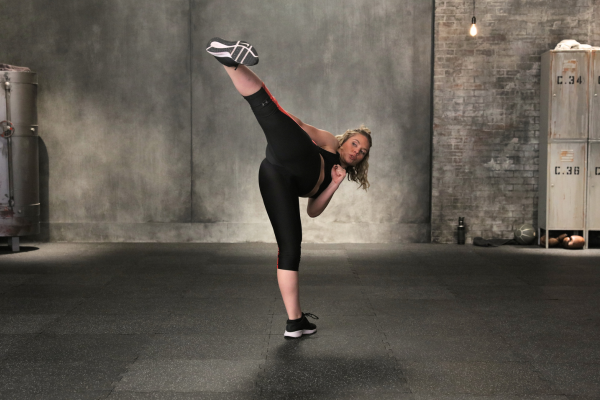How to Kick: Front and Side Kicks With Amy Johnston

Want to learn a skill that burns a ton of calories and improves your balance, power, flexibility, speed, strength — and could even save your life? You need to learn how to kick.
Knockouts are typically associated with punching, but kicking packs inherently more power, making it potentially more devastating in a fight… assuming, of course, that your technique is solid. If it’s not, you’ll miss your target, fall over, or get your foot trapped by your opponent — all of which are likely to land you in a “Martial Arts Fail” compilation video.
Avoid that disaster by following our tips below on how to perform the two most basic kicks — the front kick and the side kick — courtesy of martial artist, stunt performer, and Rough Around The Edges trainer Amy Johnston.
How to Front Kick
As its name suggests, the front kick is for striking the front surface of a target directly in front of you — such as the midsection — or for striking upward toward the groin or chin. It’s also a perfect kick to create space when an opponent’s moving in on you. Or if you need to bust down a door, action-hero style.
Do it right, says Johnston, “And much of your body weight is behind that kick. That’s a ton of force moving through your foot and hopefully stopping your opponent.”
- Assume a fighting stance: With your feet shoulder-width apart, step your right foot back slightly, and lift your right heel off the ground. Your hands should be up around your face with your elbows in for protection.
- With a slight bend in your knees, shift your weight onto your front foot and pull your back knee up to your chest, while simultaneously flexing your toes toward your shin. This is known as “chambering.”
- Push your hips toward your target while quickly extending your kicking leg, striking your target with the ball of your foot. (If practicing on a heavy bag, pick a target on the bag and try to aim there every time.)
- Retract your lower leg back to the chambered position, then return it to the floor.
How to Side Kick
Naturally enough, the side kick is for attacking a target to your left or right. Performed correctly, it brings your hips, core, and all the rotational muscles of your trunk into play, making it a devastating, fight-ending kick if you time it right.
Because of its long reach, says Johnston, “It’s a nice move for keeping your enemy away.”
- From a right-foot-forward fighting stance, turn your head and rotate your guard slightly to your right.
- Draw your right knee up to the chambered position, toes flexed toward your shin, heel pointing toward your target.
- Keeping your knee high, rotate your hips so that your butt is toward your opponent, and the toes of your supporting foot point directly away from your target.
- Quickly extend your right leg directly toward your target while simultaneously leaning left, and strike with the outer edge (or blade) of your foot. (Because of the position of your hips, it may feel like you’re kicking backward.)
- Return to the chambered position, and lower your foot to the ground.
Tips for Proper Kicking
- Start slowly, emphasizing proper technique, gradually increasing power and speed as you gain confidence.
- “Breathing is very important,” says Johnston. “It helps to keep you relaxed.” Accompany each kick with a sharp exhale of breath.
- Stay low as you kick — don’t rise up on your supporting leg.
- Practice both kicks with both your dominant and non-dominant sides, switching up your fighting stance as necessary.






